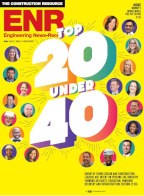"It enabled us to take all the work that had been done and implement it into something that [the selection committee] could really correlate and relate to what's going to be in their backyards, instead of just seeing it on thousands of pieces of paper."
Allen says he relies on professional printing operations, such as NRI, for 3D printing because their tools and understanding of the technology almost certainly will be more up-to-date than what he could sustain by having a printer in his own office. He says he also learned a lot about preparing files for 3D model printing in the process of competing for the Tappan Zee.
"You really have got to have clean, well-managed and well-put-together 3D BIM files," Allen says. "We had them done in 3D from the design standpoint, but we then spent another week cleaning them up. It's hard to look at a file and just know [if it's clean]," he says. "But sharp edges really are hard for the printer to print. If you cope edges and corners where things meet, it helps a lot as well as making sure everything is closed, and you don't have any overlapping solids. We had people from all around the country working on different parts of the design model, and any misalignments at all causes problems for the printer. I was shocked at how exact the printer can really get."
Justin Levitz, NRI 3D technology director, says 3D is the fastest-growing part of its business. "Our customers say it's so much easier for their clients to understand and get a feeling for what the building is actually going to be like when they can touch it. It has just taken off."
"I am fascinated by the technology," adds Barrett. "It's a great case of disruption in innovation. You can watch it change as they make bigger pieces, better, faster. … You can just see the trajectory."











